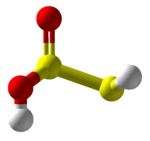Thiosulfurous acid
Thiosulfurous acid (HS−S(=O)−OH) is a low oxidation state (+1) sulfur acid.[3] It is the equivalent acid for disulfur monoxide. Thiosulfurous acid is formed by reacting hydrogen sulfide and sulfur dioxide at room temperature.[4] The thiosulfurous acid molecule is unstable when condensed, reacting with itself.[5]
 | |||
| |||
| Names | |||
|---|---|---|---|
| IUPAC names | |||
| Systematic IUPAC name
hydroxidooxidosulfanidosulfur[1] | |||
| Other names
sulfurothionous acid | |||
| Identifiers | |||
3D model (JSmol) |
|||
| ChEBI | |||
| ChemSpider | |||
| 184467 | |||
PubChem CID |
|||
| |||
| |||
| Properties | |||
| HS-S(=O)-OH | |||
| Molar mass | 98.14668 | ||
| Conjugate base | Thiosulfite | ||
| Related compounds | |||
Related compounds |
thiosulfuric acid SSO thiosulfinic acid | ||
Except where otherwise noted, data are given for materials in their standard state (at 25 °C [77 °F], 100 kPa). | |||
| Infobox references | |||
It decomposes to polysulfane oxide or polythionic acids in water which is termed Wakenroder's liquid.[6]
Other possible isomers are dihydroxydisulfane or hypodithionous acid HOSSOH, a linear chain, and thiothionyl hydroxide (S=S(OH)2) a tautomer where the hydrogen has moved from a sulfur to an oxygen.[6] HOSSOH can have two different rotamers with symmetry C1 and C2. The isomer with one hydrogen on sulfur and one on oxygen is the most stable according to calculations.[7]
Reactions
Thiosulfurous acid can be formed during the hydrolysis of disulfur dichloride.
In alkaline conditions thiosulfurous acid rapidly deteriorates forming a mixture of sulfide, sulfur, sulfite, and thiosulfate. In acidic conditions it will form hydrogen sulfide and sulfur dioxide as well. Some of these react to form pentathionate and other polythionates. Thiosulfurous acid reacts with sulfurous acid to give tetrathionate, and with thiosulfuric acid to make hexathionate.[8]
Salts
Salts of thiosulfurous acid are named "thiosulfites" or "sulfurothioites". The ion is S=SO2−
2. However they are unknown.
Esters
Four isomers are possible for R2S2O2, at least restricting sulfur to di- and tetravalency: (RO)2S=S, ROSSOR, RS(O)2SR, and RS(O)SOR. For the first two, the R groups are equivalent, and in the latter two they are nonequivalent. A simple example is diethylthiosulfite, (EtO)2S=S. It is also known as diethylthionosulfite. It is a stereochemically rigid on the NMR timescale to about 140 °C, somewhat similar to diethylsulfoxide. Many derivatives have been prepared from glycols. From meso-hydrobenzoin (PhCH(OH)−CH(OH)Ph), one obtains two isomers; a third isomer results from d,l-PhCH(OH)−CH(OH)Ph.[9][10]
The reaction with simple alkoxide sources with disulfur dichloride gives the unbranched ROSSOR. They are immiscible in water, but dissolve in benzene or carbon tetrachloride.[8] These species are less rigid than the thiosulfite esters.
References
- International Union of Pure and Applied Chemistry (2005). Nomenclature of Inorganic Chemistry (IUPAC Recommendations 2005). Cambridge (UK): RSC–IUPAC. ISBN 0-85404-438-8. p. 139. Electronic version.
- ACD Chemsketch Name Free
- +1 is the average oxidation state of the two structurally different sulfur atoms. The exterior atom has an oxidation number of −1 while the central sulfur atom has the oxidation state of +3.
- "Thioschweflige Säure - Chemgapedia". Retrieved 3 November 2013.
- Schmidt, Heinar; Ralf Steudel; Detlev Suelzle; Helmut Schwarz (1992). "Sulfur compounds. 148. Generation and characterization of dihydroxy disulfide, HOSSOH: the chainlike isomer of thiosulfurous acid". Inorganic Chemistry. 31 (6): 941–944. doi:10.1021/ic00032a004. ISSN 0020-1669.
- Wiberg, Egon; Wiberg, Nils (2001). Inorganic Chemistry. Academic Press. p. 552. ISBN 9780123526519. Retrieved 3 November 2013.
- Miaskiewicz, Karol; Ralf Steudel (1991). "Sulphur compounds. Part 140. Structures and relative stabilities of seven isomeric forms of H2S2O2". Journal of the Chemical Society, Dalton Transactions (9): 2395. doi:10.1039/DT9910002395. ISSN 0300-9246.
- Nair, C. G. Ramachandran; A. R. Vasudeva Murthy (19 June 1961). "Hydrolytic Reactions of Esters and Amides of Thiosulfurous Acid" (PDF). Proceedings of the Indian Academy of Sciences. Bangalore. 56 (3): 130–140.
- Eli Zysman-Colman David N. Harpp "Dialkoxy Disulfides And Their Branch-bonded Thionosulfite Isomers" J. Sulfur Chemistry 2004, vol. 25, pp. 155–182. doi:10.1080/1741599342000202176
- Zysman-Colman, Eli; Charles B. Abrams; David N. Harpp (2003). "Synthesis of New Cyclic Thionosulfites". The Journal of Organic Chemistry. 68 (18): 7059–7062. doi:10.1021/jo0346306. ISSN 0022-3263. PMID 12946149.

